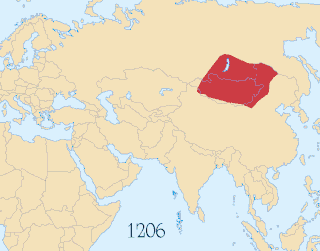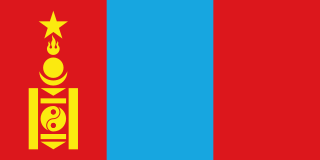 W
WThe Chagatai Khanate or Chagatai Ulus was a Mongol and later Turkicized khanate that comprised the lands ruled by Chagatai Khan, second son of Genghis Khan and his descendants and successors. At its height in the late 13th century, the khanate extended from the Amu Darya south of the Aral Sea to the Altai Mountains in the border of modern-day Mongolia and China, roughly corresponding to the defunct Qara Khitai Empire. Initially the rulers of the Chagatai Khanate recognized the supremacy of the Great Khan, but by the reign of Kublai Khan, Ghiyas-ud-din Baraq no longer obeyed the emperor's orders. During the mid-14th century, the Chagatais lost Transoxania to the Timurids. The reduced realm came to be known as Moghulistan, which lasted until the late 15th century when it broke off into the Yarkent Khanate and Turpan Khanate. In 1680, the remaining Chagatai domains lost their independence to the Dzungar Khanate and in 1705, the last Chagatai khan was removed from power, ending the dynasty of Chagatai.
 W
WThe Dzungar Khanate, also written as the Zunghar Khanate, was an Inner Asian khanate of Oirat Mongol origin. At its greatest extent, it covered an area from southern Siberia in the north to present-day Kyrgyzstan in the south, and from the Great Wall of China in the east to present-day Kazakhstan in the west. The core of the Dzungar Khanate is today part of northern Xinjiang, also called Dzungaria.
 W
WThe Golden Horde or Ulug Ulus - lit. “Great State” in Turkic was originally a Mongol and later Turkicized khanate established in the 13th century and originating as the northwestern sector of the Mongol Empire. With the fragmentation of the Mongol Empire after 1259 it became a functionally separate khanate. It is also known as the Kipchak Khanate or as the Ulus of Jochi.
 W
WThe Ilkhanate, also spelled Il-khanate, known to the Mongols as Hülegü Ulus was a khanate established from the southwestern sector of the Mongol Empire, ruled by the Mongol House of Hulagu. Hulagu Khan, the son of Tolui and grandson of Genghis Khan, inherited the Middle Eastern part of the Mongol Empire after his brother Möngke Khan died in 1260. Its core territory lies in what is now part of the countries of Iran, Azerbaijan, and Turkey. At its greatest extent, the Ilkhanate also included parts of modern Iraq, Syria, Armenia, Georgia, Afghanistan, Turkmenistan, Pakistan, part of modern Dagestan, and part of modern Tajikistan. Later Ilkhanate rulers, beginning with Ghazan in 1295, converted to Islam. In the 1330s, the Ilkhanate was ravaged by the Black Death. Its last khan Abu Sa'id died in 1335, after which the khanate disintegrated.
 W
WThe Jalayirid Sultanate was a Persianate Mongol Jalayir dynasty which ruled over Iraq and western Persia after the breakup of the Mongol khanate of Persia in the 1330s. It lasted about fifty years, until disrupted by Timur's conquests and the revolts of the Kara Koyunlu Turkmen. After Timur's death in 1405, there was a brief attempt to re-establish the sultanate in southern Iraq and Khuzistan. The Jalayirids were finally eliminated by the Kara Koyunlu in 1432.
 W
WThe Kalmyk Khanate was an Oirat khanate on the Eurasian steppe. It extended over modern Kalmykia and surrounding areas in the North Caucasus, including Stavropol and Astrakhan. During their independence, the Kalmyks both raided and allied with Russia in turn, engaging in numerous military expeditions against the Crimean Tatars, the Ottoman Empire, neighboring Muslim tribes, and the highlanders of the North Caucasus. The Khanate was annexed by the Russian Empire in 1771.
 W
WKara Del or Qara Del was a Mongol kingdom that existed in Hami in present-day Xinjiang. It was founded by the Yuan prince Gunashiri, a descendant of Chagatai Khan, in the late 14th century (c.1389), and ruled by the Chagatayids thereafter until 1463. From 1380, it began to tribute to Ming dynasty. From 1406, it was governed by Ming under the Kara Del Guard, however sometimes it was still under the influence of Northern Yuan, and the ruler was called the Obedient King under the Jimi system. It was destroyed as a result of the wars between Ming China and Oirat Mongols and dynastic succession struggles in 1513. Kara Del means "Black chest" in the Mongolian language.
 W
WThe Khoshut Khanate was an Oirat khanate based in the Tibetan Plateau from 1642 to 1717.
 W
WMoghulistan, also called the Eastern Chagatai Khanate, was a Mongol breakaway khanate of the Chagatai Khanate and a historical geographic area north of the Tengri Tagh mountain range, on the border of Central Asia and East Asia. That area today includes parts of Kazakhstan, Kyrgyzstan, and northwest Xinjiang, China. The khanate nominally ruled over the area from the mid-14th century until the late 17th century, although it is debated whether it was a continuation of the Chagatai Khanate, an independent khanate, or a tributary state to Ming Dynasty China.
 W
WThe Mongol Empire of the 13th and 14th centuries was the largest contiguous land empire in history. Originating in Mongolia in East Asia, the Mongol Empire eventually stretched from Eastern Europe and parts of Central Europe to the Sea of Japan, extending northward into parts of the Arctic; eastward and southward into the Indian subcontinent, Mainland Southeast Asia and the Iranian Plateau; and westward as far as the Levant and the Carpathian Mountains.
 W
WMongolia is a landlocked country in East Asia. Its area is roughly equivalent with the historical territory of Outer Mongolia, which is sometimes used to refer to the current state. It is situated between Russia to the north and China to the south, where it neighbours the Inner Mongolia Autonomous Region. Mongolia does not share a border with Kazakhstan, although only 37 kilometres separate them.
 W
WThe Bogd Khanate of Mongolia was the government of Mongolia between 1911 and 1919 and again from 1921 to 1924. By the spring of 1911, some prominent Mongolian nobles including Prince Tögs-Ochiryn Namnansüren persuaded the Jebstundamba Khutukhtu to convene a meeting of nobles and ecclesiastical officials to discuss independence from the Manchu-led Qing China. On November 30, 1911 the Mongols established the Temporary Government of Khalkha. On December 29, 1911 the Mongols declared their independence from the collapsing Qing Empire following the Xinhai Revolution. They installed as theocratic sovereign the 8th Bogd Gegeen, highest authority of Tibetan Buddhism in Mongolia, who took the title Bogd Khaan or "Holy Ruler". The Bogd Khaan was last khagan of Mongolia. This ushered in the period of "Theocratic Mongolia", also known as the Bogd Khanate.
 W
WThe Mongolian People's Republic was a unitary sovereign socialist state which existed between 1921 and 1992, coterminous with the present-day country of Mongolia in East Asia. It was ruled by the Mongolian People's Revolutionary Party and maintained close links with the Soviet Union throughout its history. Geographically, it was bordered by China to its south and the Soviet Union to its north. Until 1944, it also bordered the Tuvan People's Republic, a Soviet satellite state recognized only by Mongolia and the Soviet Union.
 W
WThe Mughal Empire, Mogul or Moghul Empire, was an early-modern empire in South Asia. For some two centuries, the empire stretched from the outer fringes of the Indus basin in the west, northern Afghanistan in the northwest, and Kashmir in the north, to the highlands of present-day Assam and Bangladesh in the east, and the uplands of the Deccan plateau in south India.
 W
WTartary or Great Tartary was a historical region in Asia located between the Caspian Sea-Ural Mountains and the Pacific Ocean. Tartary was a blanket term used by Europeans for the areas of Central Asia, North Asia, and East Asia unknown to European geography. It encompassed the vast region of the Pontic-Caspian steppe, the Volga-Urals, the Caucasus, Siberia, Inner Asia, Mongolia and Manchuria.
 W
WThis is a timeline of the Yuan dynasty (1271–1368).
 W
WThe Timurid Empire, self-designated as Gurkani, was a Persianate Turco-Mongol empire comprising modern-day Uzbekistan, Iran, the southern Caucasus, Mesopotamia, Afghanistan, much of Central Asia, as well as parts of contemporary India, Pakistan, Syria and Turkey.
 W
WThe Yuan dynasty, officially the Great Yuan, was a successor state to the Mongol Empire after its division and a ruling dynasty of China established by Kublai Khan, leader of the Mongol Borjigin clan, lasting from 1271 to 1368. In Chinese historiography, this dynasty followed the Song dynasty and preceded the Ming dynasty.
 W
WThe Northern Yuan was a dynastic regime ruled by the Mongol Borjigin clan based in the Mongolian Plateau. It operated as a rump state after the collapse of the Yuan dynasty of China in 1368 and lasted until its conquest by the Jurchen-led Later Jin dynasty in 1635. The Northern Yuan dynasty began with the end of Yuan rule in China proper and the retreat of the Yuan remnants led by Toghon Temür to the Mongolian steppe. This period featured factional struggles and the often only nominal role of the Great Khan.